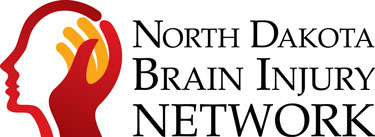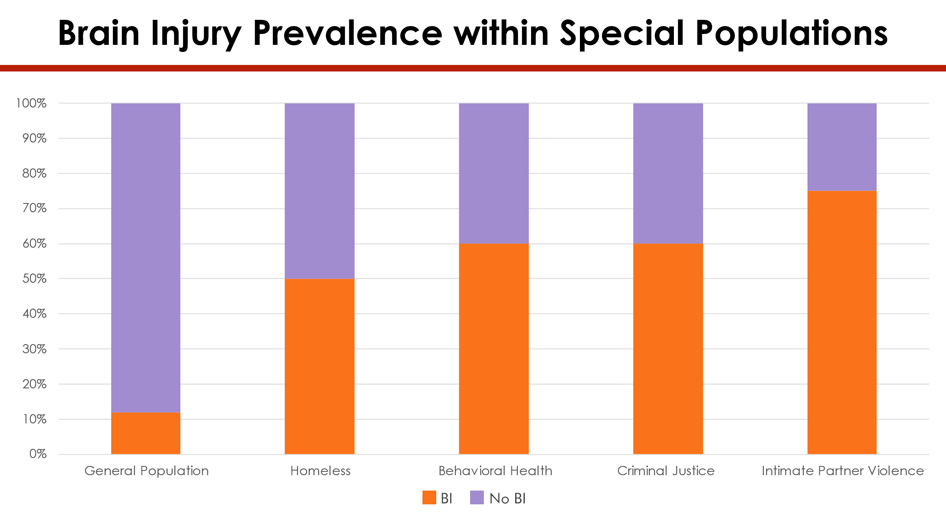Special Populations
When we look at the research on what types of individuals sustain brain injuries, there are certain populations of people that are over represented. Twelve percent of the general population have a history of brain injury, while the homeless population prevalence is 50% with the majority of those injuries being sustained prior to homelessness. Behavioral health (mental health and substance use disorders) prevalence of brain injury is 60%. Those involved in the criminal justice system also have a prevalence rate of 60%, and those having experienced interpersonal violence have a rate of 75%.
The North Dakota Brain Injury Network (NDBIN) finds these numbers unacceptable and is making efforts to reduce the number of brain injuries among these special populations. Learn about resources and information specific to each of these special populations.
 Criminal Justice
Criminal Justice
The American criminal justice system has a large number of inmates with a history of brain injury. There are many contributing factors to this statistic, and we at NDBIN know that North Dakota can help reduce this number.
Ways NDBIN Can Help
- Support groups – We can advertise and refer individuals to groups and provide or help find facilitators.
- NDBIN can help support groups access Specialized Support Group Curriculum – These curriculums work on understanding the makeup of the brain, the injury, and the healing process through structured activities and information sharing.
- A.H.E.A.D - Achieving Health through Education, Accountability and Determination: A Psycho-Education Curriculum for TBI can also be provided for you by NDBIN. This curriculum was designed by Colorado's Brain Injury Alliance for use within the criminal justice system.
- The Substance Use and Brain Injury Group uses a curriculum designed for those who are in recovery from substance use and have a brain injury.
- Resource facilitation – Call or email NDBIN, and we can help you find resources in your area that are appropriate for you.
- Peer-to-Peer Mentoring involves pairing individuals with peer support specialist.
Resources
 Homelessness
Homelessness
Often brain injury and homelessness work in tandem. Ninety percent of individuals with a brain injury report that their first injury was sustained prior to becoming homeless.
Individuals with a history of traumatic brain injury who also experience homelessness tend to struggle with:
- Physical and mental health
- Substance use
- Suicidal ideation or attempts
- Memory
- Involvement in the criminal justice system
Resource
 Intimate Partner Violence
Intimate Partner Violence
Unfortunately, many individuals, women in particular, are overrepresented in the brain injury world due to interpersonal violence. If someone is hurting you, please get help! For more information on resources to help get you out of these unhealthy relationships, call (855) 866-1884 or email info@ndbin.org.
Resources
- Brain Injury and Intimate Partner Violence Infographic
- Invisible Injuries Packet
- Invisible Injuries Rack Card
 Mental Health
Mental Health
Oftentimes, individuals with a brain injury struggle with mental health issues, such as anxiety and depression. There are many options for you to try to get a handle on these issues.
Resources
- North Dakota Mental Health Providers
- Emotional Dysregulation
- Brain Injury & Mental Health Infographic
 Substance
Use
Substance
Use
Substance use following brain injury can be a slippery slope. After individuals sustain injuries, their inhibitions become lowered, allowing them to be much more susceptible to using and, under certain circumstances, misusing substances.
Resources
- Traumatic Brain Injury and Substance Use Disorders: Making the Connections – The National Association of State Head Injury Administrators (NASHIA) partnered with the Mid-America and Mountain Plains Additions Technology Transfer Centers and Dr. Carolyn Lemsky to produce a toolkit for addictions.
- Client Workbook: Substance Use and Brain Injury – NASHIA produced this workbook, written by Dr. Carolyn Lemsky and Dr. Tim Godden, as a resource for people who are living with the effects of a brain injury and are wondering how their substance use may be affecting them.
- Substance Abuse as a Mediating Factor in Outcome from Traumatic Brain Injury – If you heard anyone from NDBIN present before, you've probably heard us reference John Corrigan's study on brain injury and alcohol.
- Substance Use and TBI – This FREE online course offered by NDBIN covers the impact a brain injury can have on substance use disorder and treatment approaches for working with individuals with brain injury.
- Brain Injury & Substance Abuse Infographic

